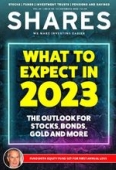Archived article
Please note that tax, investment, pension and ISA rules can change and the information and any views contained in this article may now be inaccurate.
Discover what the yield curve is telling investors right now

America’s S&P 500 is up by 11% in the last two months and the UK’s FTSE All-Share by 10% from the bottoms seen in early October. This may seem counter-intuitive, as the Organisation for Economic Co-operation and Development (OECD), the International Monetary Fund (IMF) and Office for Budget Responsibility (OBR), to name but three, all pile on with forecasts of recession in 2023.
And it looks ever odder at a time when one tried-and-tested recession indicator – the yield curve – is also signalling with growing conviction that a downturn is coming and possibly soon.
Yet there may be method in markets’ madness, despite the apparent contradiction.
Deeper and down
First things first: the so-called yield curve is now deeply inverted in the US and has just inverted in the UK, using the 2s-10s curve as the benchmark.
Usually, 10-year government bonds will yield more than two-year paper simply because more can go wrong in the additional eight-year period. Investors will demand a higher yield as compensation for the added risk.
But when markets sniff out a recession, they start to price in interest rate cuts. Reductions in headline borrowing rates set by central banks will usually drag down yields on government bonds in sympathy and that is what we are seeing now. Since the 12 October stock market low, the yield on US two-year treasuries is pretty much flat at 4.3% but the yield on 10-year bonds is down 41 basis points to 3.49%. As a result, the US yield curve is deeply inverted, in fact more deeply than since the twin recessions of the early 1980s when then-Fed chair Paul Volcker was also jacking up interest rates to crush inflation.
In the UK, the 2s-10s yield curve for gilts has just inverted. Yields have come down across the board after the panic caused by the nation’s brief flirtation with Trussonomics, but since the 12 October the two-year yield is down by 70 basis points and the 10-year by 143.

Whatever you want
However, both charts also make it clear that equity markets are not listening to the warnings of recession. They are focusing on the interest rate cuts instead, since they are designed to make credit cheaper, boost loans, oil the economic engine and fuel a fresh upcycle.
The theory is that central banks seem to be slowing the rate of interest rate increases, and if rate increases are slowing then they will finally stop, and the next logical step is interest rate declines. In sum, this is the argument in favour of a monetary policy pause and then pivot, with the idea being that a recession will help central banks to stop worrying about inflation and get them to focus on growth instead.

In effect, markets are calling central banks’ bluff, as they continue to talk tough on inflation and interest rates. You can understand why, given that every major financial market meltdown or economic downturn since the Russian debt default and LTCM hedge fund chaos of 1998 has been met with frantic interest rate cuts and, more recently, dollops of quantitative easing.
What you’re proposing
Stock (and bond) markets are both latching on to this narrative, making gains even as the economy apparently loses speed. This makes sense in that the stock market and the economy are different things. The FTSE 100 derives the majority of its earnings from overseas for starters. In addition, share prices will try to price in future events, rather than wait for the economic data to come through, especially as most of this will be released with a lag, not least because of the time it takes to compile the numbers. But it might not be that simple.

The Fed and the Bank of England slashed interest rates in 2000-2002 and again in 2007-2009 and eventually their economies righted themselves and bear markets in shares came to an end – but they key word here is eventually.
Rate cutting did not initially save investors from a mauling and headline stock indices have tended to top out when the yield curve is at its most inverted and that was because the recession (as predicted by the yield curve) kicked in and took corporate earnings down with it.
The past is no guarantee for the future, but it seems that the battle lines are set: rate cuts versus earnings downgrades. At least in the UK’s case, valuation multiples and dividend yields feel like they are pricing in deeper drops in earnings than the US market is currently expecting (and analysts are still forecasting higher corporate profits in 2023 on both sides of the Pond). We shall see.

Important information:
These articles are provided by Shares magazine which is published by AJ Bell Media, a part of AJ Bell. Shares is not written by AJ Bell.
Shares is provided for your general information and use and is not a personal recommendation to invest. It is not intended to be relied upon by you in making or not making any investment decisions. The investments referred to in these articles will not be suitable for all investors. If in doubt please seek appropriate independent financial advice.
Investors acting on the information in these articles do so at their own risk and AJ Bell Media and its staff do not accept liability for losses suffered by investors as a result of their investment decisions.
Issue contents
Feature
- We reveal the best performing UK stocks in 2022: large and small
- The outlook for stocks, bonds, gold and more: what to expect in 2023
- Why investors can’t afford to overlook Europe’s growth and income champions
- Discover what fund managers got right and wrong in 2022
- Bad year for investors Terry Smith and Nick Train but Warren Buffett is a winner
Great Ideas
News
- Regulators put Microsoft and Meta under scrutiny as big tech growth slows
- Chemring’s cybersecurity hidden jewel is starting to shine
- How freezing temperatures saw power prices rocket to record levels
- Why consumer squeeze and higher rental rates have clobbered Airbnb shares
- Balfour Beatty shares hit 11-year high on booming infrastructure market
- Could the Royal Mail final dividend be decided in Westminster?
- House prices cooling quickly after two years of red-hot growth

 magazine
magazine








